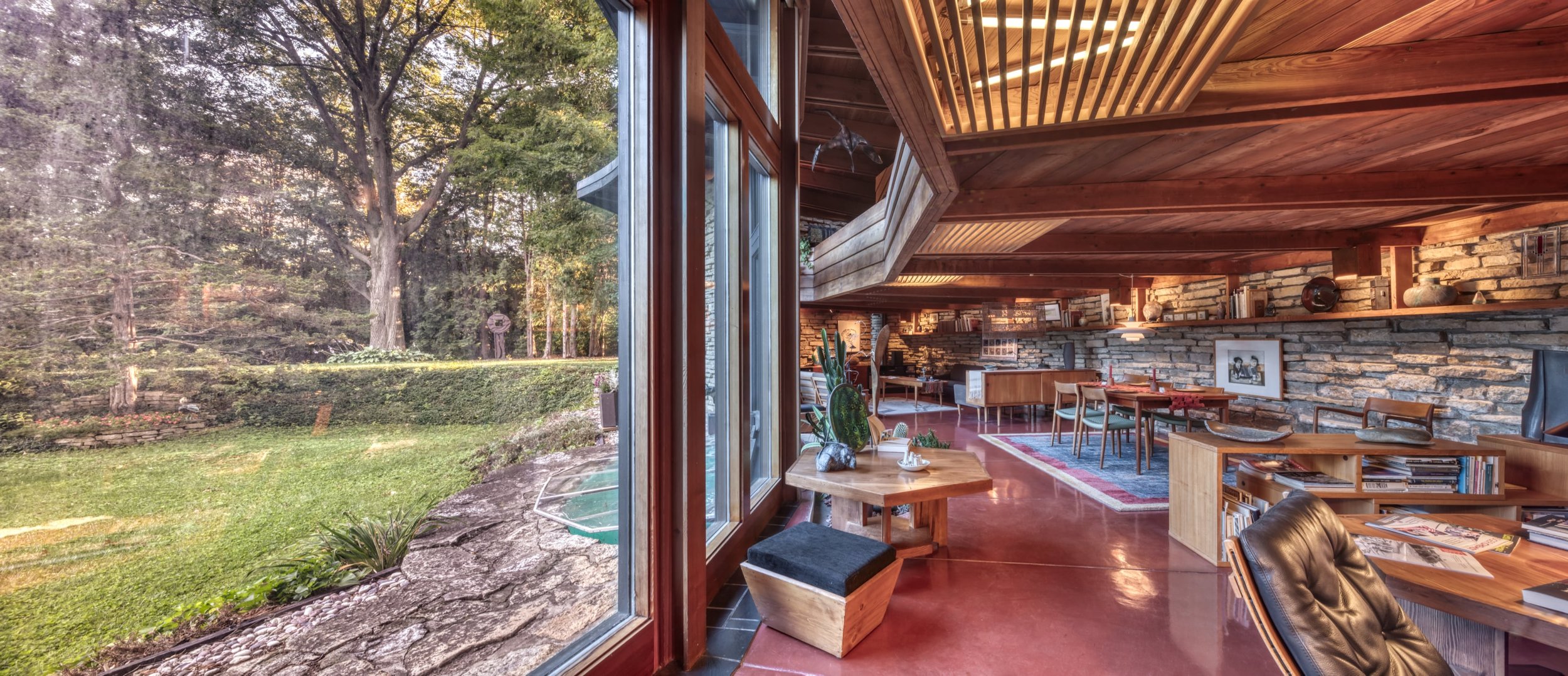The Herbert and Katherine Jacobs II House
The most exciting part of my #500fllwproject is of course the actual photographing of the designs buuuut the second is doing the research sometimes before and sometimes after I photograph.
The Herbert and Katherine Jacobs II house in Middleton, Wisconsin is a popular design, so I came in knowing a bunch about the Solar Hemicycle design. What I didn’t know (in detail) was the relationship between the owners and Wright and how the house came to be. So, I ordered the book “Building with Frank Lloyd Wright.” This is the first-hand account of the young couple, Herbert and Katherine, who challenged Wright to produce a decent house for $5,000 in 1936. It's a great book if you’re interested in the design.
First I need to mention that the Jacobs II house was actually the second home Herbert and Katherine commissioned Wright to design. The first was Jacobs I, in which they lived for a few years.
Here is a very brief history of how the Jacobs house came to be.
I was surprised to learn that the Jacobs II house design was not the first Frank Lloyd Wright showed the Jacobs for their second home. The first was actually something completely different.
The first design proposed for the Jacobs II House.
It was this design, shown as a perspective and floor plan. Wright told them they could do a lot of the construction themselves, but both Herbert and Katherine rejected it. Based on letters written in Dec. 1943, they decided it was “more elaborate than we felt suited us and that it did not invite the informal way of life we had learned to love in the first house…what we wanted---still do, for that matter---was something considerably smaller and less costly, and without great spaces to be heated during the winter” Side note: Though accepted by later clients, this house was never built.
Fast forward to Feb 8th, 1944, when Wright wrote to the Herberts, inviting them to Taliesin to see the second option. They drove up to Taliesin on Feb 13th, and Wright showed them an entirely new and original design that was like nothing they or the world had seen before.
“You are getting another first, Wright said, “Here is the answer to the problem of what to build on a hilltop exposed to the full sweep of the wind...the house creates its own site and its own view.”
Solar hemicycle design proposed for the Jacobs II House.
At that Taliesin meeting, Wright proposed what he called a solar hemicycle house. “In a solar hemicycle design, with the big windows at the front, the low-lying winter sun would come deep into the house and help to warm it by heating the rock walls in the back. The high summer sun would be cut off by the roof overhang,” Wright said. “The other feature to counter the cold weather, he declared, was the creation of an airfoil by streamlining it in place. The sunken garden in front of the hemicycle acts to form a ball of dead air, and the long slope of dirt against the back wall is necessary so that the wind will blow over their house instead of against it. Wright said, “When it's finished, you can stand on the front terrace in a strong wind and light your pipe without any trouble. With little wind blowing against it, and with the massive dirt at your back, your heating costs will be very low.” The conversation ended with Wright assuring the Herbert’s that this house could be built for $5,000.
Madison City Boathouse on Lake Mendota (1893).
Wright had used the same dug-in house system before when he designed the Madison City Boathouse on Lake Mendota in 1893. It was demolished in 1926. And yes, the pipe-lighting ceremony was performed to perfection.
The Jacobs II project was as a private residence, small in scale and comparatively low in cost. But what was so special about this project is that Wright was exploring new circular forms. No one knows the inspiration for the semi-circular house, but we do know he was deep in the plans for the Guggenheim Museum. He had also designed the Lloyd Burlingham house in El Paso, TX in 1941. It has two interlocking arcs enclosing a courtyard that protects the inhabitants from the desert wind and dust. If you take away one of the arcs, can you start to see the shape of the Jacobs II design?
Lloyd Burlingham house in El Paso, Texas (1941).
One of the things I love about Frank Lloyd Wright is that he was constantly experimenting, tweaking, and evolving design elements throughout his career. It’s really interesting to see different elements in his designs across the country.
My (random) FIELD NOTES:
ACCESS & OVERVIEW
I am pretty darn excited with every new Wright design I get the opportunity to photograph, but I was especially excited to photograph Jacobs II. I love the thoughtful design of the Solar hemicycle, which takes advantage of the sun and simultaneously shelters from harsh winds. These days I see so many homes for which there is very little thought of the environment and the position of the house on the site. For me, the Solar Hemicycle is Wright’s MOST responsive design to the environment and living with nature. Do you agree?
I got a commission to highlight the “Wright Trail” with Travel Wisconsin a few years ago and came very close to photographing Jacobs II, but we couldn’t make it work. Needless to say, I was super bummed. back in July 2022, I was fortunate to have a Wright organization introduced me to the owners, and the owners were gracious enough to join the project and I was off.
I leave my camera equipment in the car when I first arrive at a Wright design for two reasons. I want to take in the design with all my senses. That just doesn’t happen with a camera in hand. I dare you to try walking through a Wright design with a camera and NOT take a photo… =) With a camera, one immediately sees the design through a screen and becomes hyper focused on a certain aspect of the design when it should all be taken in. I also want to hear from the owners. I want to get to know them and hear stories about them in the house. An owner tour is the best way to get to know a design. As I walk around with them, I take mental notes and create a shot list in my head based on the information I hear from them and what I see. Then I organize these compositions into what I call a “timeline of light.” Where is the sun or light on each composition, and how will that light change in the next few hours. Then they’re organized in a timeline depending on that light. A subject is only as good as its light.
WEATHER AND TIMING:
Because of the sun’s angle to the big windows, I wanted to start later in the afternoon and slowly work with the light as it softens towards sunset. I was hoping for some direct sunlight to shoot with, but this is Wisconsin in August, so that unfortunately did not happen, and I had to make do with the light that Mother Nature provided, which was not that =)
THOUGHTS:
A beautifully curved stairwell up to the second floor. Jacobs II House.
Most of the photos I had seen included minimal furniture, and the space appeared smaller than I expected when I experienced it for the first time. There didn’t need to be less furniture; it was just that the square footage was smaller than I had realized. It’s really just one open space, and I love that. It’s a perfect size for me; the ceiling never felt too low.
I was really blown away by the stonework. It reminded me of Fallingwater and Taliesin, and it got me thinking about how important the stones are in the design. They play a huge part in the theory behind the solar hemicycle. They also provide a feeling of really living in a space, not just somewhere with white walls that hide the design. The stones feel protective. That lead me to my first composition, which was of the stairwell, which curves beatifully up to the second floor. I fell in love with them instantly.
By the time the sun was coming down, the clouds were starting to breakup, and I wanted night shots…baaaaad. I was after that deep, rich blue color that happens in the sky just after sunset. I’m a huge fan of nighttime long exposure photography, and with a 48-foot curving wall of 14-foot tall glass. I knew they had the potential to be exceptional. But I had to take them in way that both highlighted the interior and exterior together, and they had to accentuate the curved shape of the design.






